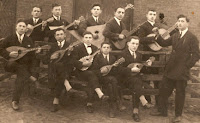Friday's episode of
Who Do You Think You Are? followed Rosie O'Donnell as she researched her mother's side of the family. Her mother died when Rosie was 10, and she mentioned that her family never talked about the past, so she knew almost nothing going into the research.
This episode had a lot of things I really liked that I have not seen in previous episodes. Rosie said at the beginning that she wanted her research to make her ancestors fully fleshed-out individuals. Someone in the family is the keeper of the family photos and that kind of stuff. (He isn't a celebrity, though, so Rosie is the one who got to do the show.) Rosie said to her brother as they were looking through the photos, "It's not gonna be as easy as it looks on TV." (It still was that easy for her, of course, because the professional researchers did the work for her, but at least she acknowledged the work isn't easy.) She pursued research on a collateral line of the family (something not enough people do). She scrolled through microfilm multiple times. You could almost think the producers were listening to comments from genealogists, but I know that's impossible, because this episode had to have been in the can for a while before it was broadcast.
I really appreciated the fact that Rosie wanted to identify the photograph that had hung on the wall of the home for so many years. As the keeper of the photos and ephemera in my family, I have far too many photos that are still unidentified. And I don't know if anyone is left who would recognize the people in the photos. It was heartening to see that the cousins recognized the photo and could confirm it was indeed Anna.
And I was happy near the beginning of the episode, when Rosie was presented with a printout of the 1861 Canadian census page showing her family, that Ancestry.com was mentioned but not shown on screen. They made up for it later, when the archivist at the Québec National Archives searched the Drouin records on Ancestry.com, but at least they showed only the search form, not the Ancestry header. Yeah, I know, they're the principal sponsor. As I've said before --
product placement.
But ... there was still a lot that was pretty unrealistic. Rosie did almost all of her research by going in person to the repositories, something that is impossible for most people because of the expense, and unnecessary in a lot of instances because you can look up some of the information online. An index to New York City deaths from 1862-1948 is available on the
Italian Genealogical Group Web site; an improved search form for the database is available on Steve Morse's
One-Step Webpages. The 1900 U.S. Census, which Rosie looked at on microfilm, is available on
FamilySearch.org,
Ancestry.com, and HeritageQuest (available through many libraries) at a minimum. Most of the research was done by the professionals and waiting for Rosie when she arrived at each location.
There were also a couple of big logic problems that leaped out at me. When Rosie and the Irish genealogist were at the church looking through the parish records, they found a fourth child who had been born in Ireland. Rosie hypothesized that Patrick had died before the family had emigrated to Canada -- not an unreasonable idea. Then, when she found her family in the Poor Law Union minutes at the Kildare Library, she and the librarian both read that the family had come with four children. While I understand the focus of the segment was on the poor conditions in the workhouses, you would think there would have been at least a passing mention of the fact that Patrick had apparently been with the family when they arrived at the workhouse and the possibility (probability?) that he died there. Wouldn't you? Maybe something was said and it was edited out? It just comes off as a continuity error to me.
The other place I had a major disconnect was when Rosie was looking in the newspaper in the Grand Bibliothèque for an obituary for her great-great-grandmother. At one point she said it was "all I have to go on." What about her great-great-grandfather? He was born in Ireland also. If the researchers hadn't been able to find anything in his records that said where in Ireland he was from, at least say that. Otherwise it makes no sense why finding where her great-great-grandmother was from was her last chance. (As an aside, Rosie was incredibly calm when she found that obituary. All she did was say, "We have a winner!" I would have been doing the genealogy happy dance around the film reader.)
Even when she did find the obituary, all it said was that her great-great-grandmother was from Kildare, as in County Kildare. As anyone who has done Irish research knows, that won't get you anywhere. You need to know the townland and the parish. So it speaks well of the researchers the program uses that they were able to find the parish where the records were in Ireland.
I found it more than a little disconcerting that the comparison they chose to draw for the workhouse was a concentration camp. While I am not an expert in 19th-century Irish history, I feel that does a disservice to the administrators and officials in charge of the system. I have never heard or read that they had genocide in mind. They might not have had deep sympathy for the people who went through the system, but they weren't trying to deliberately kill them. It was an exaggerated and inappropriate metaphor. A closer analog would be a homeless shelter, but that wouldn't sound as dramatic, would it?


















